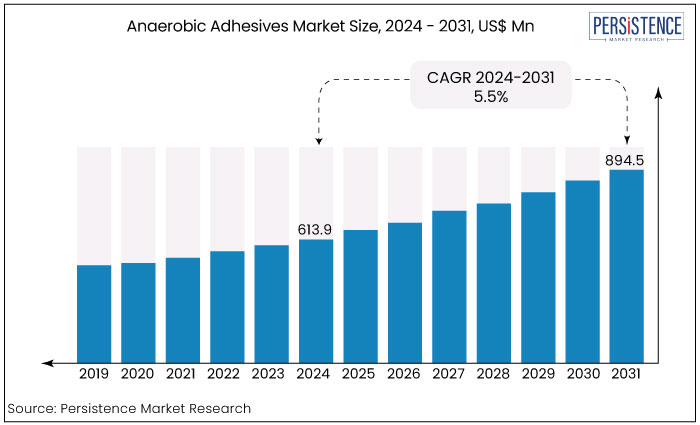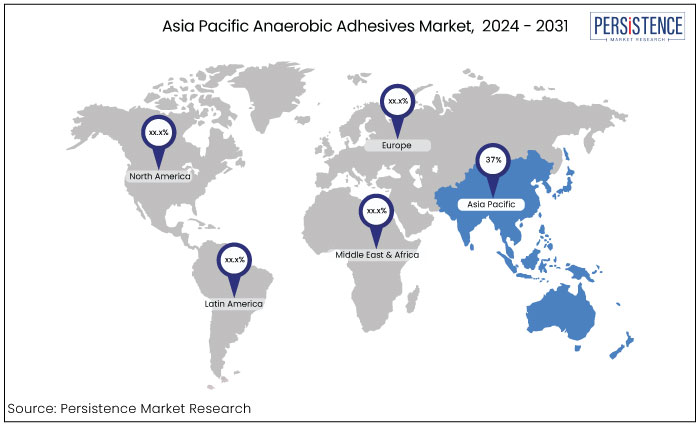Anaerobic Adhesives Market
Industry: Chemicals and Materials
Published Date: September-2024
Format: PPT*, PDF, EXCEL
Delivery Timelines: Contact Sales
Number of Pages: 171
Report ID: PMRREP34788
The anaerobic adhesives market is estimated to increase from US$613.9 Mn in 2024 to US$894.5 Mn by 2031. The market is projected to record a CAGR of 5.5% during the forecast period from 2024 to 2031. The rising demand for anaerobic adhesives in the automotive sector is one of the prime market driving factors. Asia Pacific region accumulates large market share owing to the rapid industrialization of emerging economies like India and China.

Key Highlights of the Market
|
Market Attributes |
Key Insights |
|
Market Size (2024E) |
US$613.9 Mn |
|
Projected Market Value (2031F) |
US$894.5 Mn |
|
Global Market Growth Rate (CAGR 2024 to 2031) |
5.5% |
|
Historical Market Growth Rate (CAGR 2019 to 2023) |
5% |
|
Region |
Market Share in 2024 |
|
Asia Pacific |
37% |
The region is undergoing swift economic advancement resulting in heightened industry and infrastructure initiatives. Asia Pacific to command over 37% market share. The increasing demand for anaerobic adhesives in China and India, as well as the significant number of manufacturers of automotive and electronic goods influence market expansion in the region.
The expansion of the aerospace and automotive industries and the focus on high-performance materials fosters a conducive market landscape for anaerobic adhesives in Asia Pacific. The anaerobic adhesives industry in China is essential to Asia Pacific market as it is the largest global producer of automotive and electronic products.
The automotive sector in the country is anticipated to experience considerable expansion, accompanied by a notable rise in new deliveries and a heightened need for anaerobic adhesives. Boeing's Commercial Outlook forecasts more than 8,750 additional deliveries in China by 2040, stimulating the demand for anaerobic adhesives in the automotive industry. Furthermore, China's swift economic advancement and infrastructure initiatives facilitate market expansion within the nation.

|
Category |
Market Share in 2024 |
|
Product - Thread Lockers |
33% |
Based on product, the anaerobic adhesives market is segmented into thread lockers, thread sealants and retaining compounds. Among these, thread lockers dominate the market.
Thread lockers offer a dependable and robust locking mechanism for threaded systems. They are frequently utilized for essential components like engine mounts, suspension systems, and brake callipers to guarantee that the bolts remain firmly secured, even in extreme conditions.
Thread lockers are necessary in areas like aerospace, equipment, and construction, where the dependability and integrity of threaded connections are critical. Thread sealants, or pipe sealants, are engineered to ensure a dependable seal between threaded pipe connections, thereby avoiding the escape of fluids or gasses. They are utilized on pipe fittings threads and polymerize in an anaerobic environment forming a secure and resilient seal.
An instance of the utilization of thread sealants occurs in plumbing systems. They frequently seal threaded connections in water, gas, and hydraulic piping systems. Thread sealants provide impermeable joints, averting expensive and potentially dangerous leaks.
|
Category |
Market Share in 2024 |
|
Substrate - Plastics |
45% |
Based on substrate, the anaerobic adhesives market is divided into metals and plastics. Among these, plastics substrate segment dominates the market accounting for 45% of the share. The plastic adhesives provide superior bonding properties with multiple plastic types including polypropylene, polyethylene, PVC, and ABS.
A significant application of anaerobic adhesives in plastics is assembling plastic components within the automotive sector. Plastics are utilized to adhere to plastic components within a vehicle's interior, including dashboard elements, door panels, and trim pieces. This guarantees robust and enduring connections capable of withstanding the vibrations and temperature variations seen in a vehicle.
Metals constitute another essential substrate category for anaerobic adhesives. They demonstrate remarkable adhesion characteristics with steel, aluminium, and brass metals. Significant use of anaerobic adhesives on metals is thread locking.
In sectors including manufacturing and construction, they hold threaded fasteners inhibiting loosening caused by vibrations and external forces. In the assembly of heavy gear, they are utilized on bolts and screws to guarantee their enduring stability and avert expensive equipment malfunctions.
Anaerobic adhesives are metal adhesives that may also rapidly cure in wood and plastic at room temperature. These adhesives may cure only in the absence of air or oxygen. They possess a moderate, subtle odour and are less toxic than other polymers.
Anaerobic adhesives have limited optimal applications, yet they are crucial for metal bonding. The anaerobic adhesive market is estimated to grow significantly due to various direct and indirect factors such as heightened awareness of their environmental benefits, substantial R&D investments by leading corporations, and great focus on advanced technology.
Anaerobic adhesives are employed in numerous aerospace and defence applications. The majority of countries worldwide are making substantial investments in the military sector. The number of commercial aircraft carriers has risen substantially on a global scale.
The global market for anaerobic adhesives is expanding due to many factors. Anaerobic adhesives are used to manufacture various domestic appliances, such as washing machines, clothes dryers, dishwashers, and food processors. These factors are anticipated to positively stimulate the global anaerobic adhesives market growth.
The market experienced steady growth driven by increased demand across automotive, electronics, and manufacturing industries. These adhesives known for their ability to cure in the absence of air became essential in applications requiring strong, durable bonds, particularly in metal parts like fasteners, bearings, and gaskets.
The market benefited from rising industrialization particularly in emerging economies, and the growing need for efficient and reliable bonding solutions in automotive assembly and maintenance.
Post-2024, the market is expected to witness accelerated growth due to several factors. The ongoing shift toward lightweight materials in the automotive and aerospace sectors and the need for adhesives that can replace traditional fastening methods will drive demand.
Advancements in adhesive formulations to enhance performance in extreme conditions, such as high temperatures and chemical exposure will further expand their applications. Environmental regulations encouraging the reduction of volatile organic compounds (VOCs) will also likely to boost the market as anaerobic adhesives offer low-VOC alternatives.
The expansion of renewable energy infrastructure requiring durable bonding solutions for wind turbines and solar panels will provide new growth opportunities solidifying the market’s upward trajectory.
Increasing Demand in Automotive and Aerospace Industries
The automotive and aerospace industries are significant drivers for the anaerobic adhesives market growth. These sectors require high-performance adhesives for applications such as bonding, sealing, and gaskets in engines, transmissions, and other critical components.
As these industries shift towards lightweight materials to improve fuel efficiency and reduce emissions, anaerobic adhesives become essential due to their strong bonding capabilities with metals and other substrates.
The growing trend of electric vehicles (EVs) demands advanced adhesive solutions that can withstand high temperatures and harsh conditions, further boosting the use of anaerobic adhesives. The continuous innovation in automotive and aerospace technologies and the need for reliable and durable bonding solutions are expected to drive the demand for anaerobic adhesives in these sectors.
Growing Adoption in Renewable Energy Sector
The renewable energy sector presents a significant growth opportunity for the anaerobic adhesives market. As global efforts to combat climate change intensify, the demand for renewable energy infrastructure such as wind turbines and solar panels is rapidly increasing.
Anaerobic adhesives are crucial in the assembly and maintenance of these structures providing strong, durable bonds that can withstand harsh environmental conditions. In wind turbines, for example, anaerobic adhesives are used in the bonding of rotor blades and other components, ensuring reliability and longevity.
As the renewable energy sector continues to expand, driven by government policies and investments, the demand for high-performance adhesives will rise positioning the market for robust growth.
High Cost of Raw Materials
One of the significant restraints for the anaerobic adhesives market is the high cost of raw materials. The production of anaerobic adhesives relies on specialty chemicals, which can be expensive due to the complexities involved in their synthesis and procurement.
Fluctuations in the prices of these raw materials driven by supply chain disruptions, geopolitical tensions, or changes in regulatory policies can lead to increased production costs. It affects the pricing of anaerobic adhesives, making them less competitive than other adhesives, especially in price-sensitive markets.
The high cost can also deter smaller manufacturers or those with tight budgets from adopting anaerobic adhesives, thereby limiting market growth.
Stringent Environmental Regulations
Stringent environmental regulations pose another restraint for the anaerobic adhesives market. The production and use of adhesives are subject to various environmental laws aimed at reducing the emission of volatile organic compounds (VOCs) and other hazardous substances.
Compliance with these regulations often requires manufacturers to invest in more sustainable production processes or reformulate their products to meet environmental standards. While this drives innovation, it also increases operational costs and can lead to delays in product development.
The regulatory landscape varies significantly across regions, creating challenges for companies operating in multiple markets. These factors can hinder market expansion, particularly in regions with strict environmental regulations.
Increasing Use of Electric Vehicles (EVs)
The rapid growth of the electric vehicle (EV) market offers another significant opportunity for anaerobic adhesives. As automotive manufacturers transition to electric drivetrains, there is a need for advanced adhesive solutions that can handle the unique challenges of EV design, such as high temperatures, vibration, and the need for lightweight materials.
Anaerobic adhesives are ideal for bonding and sealing components in EVs, including batteries, motors, and electronics, where traditional fastening methods may not be suitable. The expansion of the EV market driven by increasing consumer demand and government mandates for zero-emission vehicles is expected to create substantial demand for anaerobic adhesives.
The market is competitive, with key players such as Henkel AG & Co. KGaA, 3M, and Permabond LLC dominating the landscape. These companies leverage their extensive R&D capabilities and strong global distribution networks to maintain market leadership.
Key players focus on innovation and developing advanced formulations with improved performance characteristics to cater to various industries including automotive, electronics, and aerospace. Regional players and niche companies compete by offering specialized products tailored to local market needs or specific applications. The market also sees competition based on pricing, product quality, and sustainability initiatives.
As demand grows especially in emerging markets and renewable energy sectors, companies increasingly focus on strategic partnerships and acquisitions to expand their market share.
Recent Industry Developments in the Anaerobic Adhesives Market
|
Attributes |
Details |
|
Forecast Period |
2024 to 2031 |
|
Historical Data Available for |
2019 to 2023 |
|
Market Analysis |
US$ Billion for Value |
|
Key Regions Covered |
|
|
Key Market Segments Covered |
|
|
Key Companies Profiled in the Report |
|
|
Report Coverage |
|
|
Customization & Pricing |
Available upon request |
By Product
By Substrate
By End Use
By Region
To know more about delivery timeline for this report Contact Sales

The market is estimated to be valued at US$894.5 Mn by 2031.
The market is projected to exhibit a growth rate of 5.5% over the forecast period.
A few of the leading players in the market are Henkel AG & Co. KGaA, Eastman Chemical Company, and Permabond LLC.
The growing adoption in renewable energy systems drives the market forward.
Asia Pacific dominates the market for anaerobic adhesives accounting for 37% share.